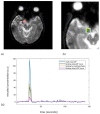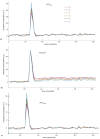Optimal Scaling Approaches for Perfusion MRI with Distorted Arterial Input Function (AIF) in Patients with Ischemic Stroke
- PMID: 35053820
- PMCID: PMC8774085
- DOI: 10.3390/brainsci12010077
Optimal Scaling Approaches for Perfusion MRI with Distorted Arterial Input Function (AIF) in Patients with Ischemic Stroke
Abstract
Background: Diagnosis and timely treatment of ischemic stroke depends on the fast and accurate quantification of perfusion parameters. Arterial input function (AIF) describes contrast agent concentration over time as it enters the brain through the brain feeding artery. AIF is the central quantity required to estimate perfusion parameters. Inaccurate and distorted AIF, due to partial volume effects (PVE), would lead to inaccurate quantification of perfusion parameters.
Methods: Fifteen patients suffering from stroke underwent perfusion MRI imaging at the Tri-Service General Hospital, Taipei. Various degrees of the PVE were induced on the AIF and subsequently corrected using rescaling methods.
Results: Rescaled AIFs match the exact reference AIF curve either at peak height or at tail. Inaccurate estimation of CBF values estimated from non-rescaled AIFs increase with increasing PVE. Rescaling of the AIF using all three approaches resulted in reduced deviation of CBF values from the reference CBF values. In most cases, CBF map generated by rescaled AIF approaches show increased CBF and Tmax values on the slices in the left and right hemispheres.
Conclusion: Rescaling AIF by VOF approach seems to be a robust and adaptable approach for correction of the PVE-affected multivoxel AIF. Utilizing an AIF scaling approach leads to more reasonable absolute perfusion parameter values, represented by the increased mean CBF/Tmax values and CBF/Tmax images.
Keywords: AIF (arterial input function); CBF (cerebral blood flow); CBV (cerebral blood volume); PVE (partial volume effect); SVD (singular value decomposition).
Conflict of interest statement
The authors report no competing interest.
Figures






References
Grants and funding
LinkOut - more resources
Full Text Sources

